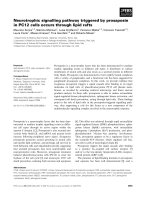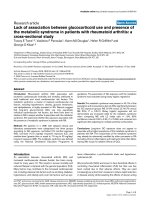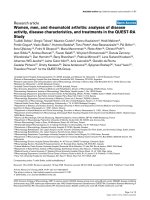Báo cáo y học: " MAPK signalling in rheumatoid joint destruction: can we unravel the puzzle? " pps
Bạn đang xem bản rút gọn của tài liệu. Xem và tải ngay bản đầy đủ của tài liệu tại đây (38.51 KB, 2 trang )
177
ERK = extracellular signal-related kinase; IL = interleukin; JNK = c-Jun N-terminal kinase; MAPK = mitogen-activated protein kinase; MMP = matrix
metalloproteinase; RA = rheumatoid arthritis; TNF = tumour necrosis factor.
Available online />Abstract
Mitogen-activated protein kinases (MAPKs) have been associated
with the pathogenesis of rheumatoid arthritis (RA), but the
individual contributions of the three MAPK family members are
incompletely understood. Although previous data have established
a role for c-Jun N-terminal kinase (JNK) and extracellular signal-
related kinase (ERK) in different animal models of arthritis, most
recent data indicate that the stable activation of p38 MAPK and in
part of ERK significantly contributes to destructive arthritis in mice
transgenic for human tumour necrosis factor-α. These data
highlight the complexity of MAPK signalling in arthritis and provide
a basis for the design of novel strategies to treat human RA.
Although all three mitogen-activated protein kinase (MAPK)
families – p38, extracellular signal-related kinase (ERK) and
c-Jun N-terminal kinase (JNK) – seem to be involved in the
activation of synovial cells in rheumatoid arthritis (RA), the
main pathways involved in the regulation of joint destruction
are incompletely understood. In this issue of Arthritis
Research & Therapy, Goertz and colleagues report some
important novel data on MAPK activation in arthritic mice
transgenic for human tumour necrosis factor-α (hTNFtg mice)
[1]. With the use of Western blotting and immuno-
histochemistry, they show that p38 MAPK and ERK are the
primarily activated MAPKs. Although activation of p38 MAPK
is more dominant in synovial macrophages, phosphorylated
ERK is also found at increased levels in synovial fibroblasts.
JNK activation is induced much less by chronic exposure to
tumour necrosis factor (TNF)-α. Applying cytokine blockers to
inhibit TNF-α-induced MAPK activation, the authors show a
significantly reduced activation of p38 MAPK and ERK in the
synovial membrane by antibodies against TNF-α.
Expression of MAPKs has previously been described at
elevated levels in the RA synovium, and data from different
animal models suggest important yet distinct roles of the
three MAPKs in destructive arthritis. However, several
questions about the regulation of joint destruction by MAPKs
remain unanswered. Thus, the predominant regulation of
collagenases (particularly matrix metalloproteinase (MMP)-
13) by JNK as suggested by Han and co-workers [2] seems
to contrast with previous studies by Mengshol and
colleagues from the group of Constance Brinckerhoff. The
latter have demonstrated a pivotal role of p38 MAPK in the
regulation of MMP-13 in human chondrocytes [3]. The
differences have been attributed in part to the peculiarities of
the rodent system. It has been suggested that, because of
the lack of a homologue to the human MMP-1 in rat and mice,
the regulation of collagenases is different in rodents and
results in a greater dependence on JNK, whereas p38 may
be of greater importance in humans [4]. However, few
functional data on the specific contribution of p38 MAPK to
cytokine-mediated joint destruction in comparison with other
MAPKs are available.
In this context, TNF-α is of importance. It can activate all three
members of the MAPK family, but p38 MAPK has been
suggested to be a key molecule mediating the response of
mesenchymal cells to TNF-α [5]. The pivotal role of TNF-α in
RA is highlighted not only by in vitro data but also by different
animal models, in which the overexpression of TNF-α results
in the development of chronic destructive arthritis [6].
The present data by Goertz and colleagues are interesting
mainly for two reasons. First, they shed new light on the
balanced activation of MAPKs during destructive arthritis and
underline the complexity of MAPK signalling. The results
confirm the notion that macrophages and synovial fibroblasts
are the major targets of TNF-α-induced MAPK activation, yet
Commentary
MAPK signalling in rheumatoid joint destruction: can we unravel
the puzzle?
Lars-Henrik Meyer and Thomas Pap
Division of Molecular Medicine of Musculoskeletal Tissue, Department of Orthopaedics, University Hospital of Munster, Munster, Germany
Corresponding author: Thomas Pap,
Published: 16 August 2005 Arthritis Research & Therapy 2005, 7:177-178 (DOI 10.1186/ar1810)
This article is online at />© 2005 BioMed Central Ltd
See related research by Goertz et al. in this issue [ />178
Arthritis Research & Therapy October 2005 Vol 7 No 5 Meyer and Pap
at the same time they strengthen the concept of p38 and
ERK as important MAPKs in the inflamed synovium. In line
with previous data, the results of Goertz and colleagues also
emphasise the role of ERK1/2 as a key integrator of
activation signals in synovial fibroblasts. In contrast, the data
may be interpreted to suggest that chronic destructive
arthritis does not require JNK activation. This notion is
supported by other recent data of Georg Schett’s group
demonstrating that JNK1 is not required for destructive joint
disease in the hTNFtg mouse model of RA [7]. The data seem
to contradict the aforementioned results in rat adjuvant arthritis
[2], but given the multitude of data on JNK activation in human
RA they more probably illustrate the complexity of human
disease in comparison with the hTNFtg model, which focuses
on only one, although central, pathway of human disease. Thus,
in human RA as well as in other animal models of RA, the
activation of JNK may be caused by another disease-relevant
signalling pathway such as IL-1, which is a potential inducer of
JNK phosphorylation in RA synovial cells. In addition, growth
factors such as epidermal growth factor, in concert with
cell–cell and cell–matrix interactions, may contribute to JNK
activation in human RA, namely by processes that seem less
prominent in the hTNFtg mouse model. This hypothesis is
supported by most recent research on upstream MAPK
kinases (MKKs), which largely determine the balance of MAPK
activation in response to inflammatory stimuli [8,9].
The second interesting observation by Goertz and colleagues
is the inability of TNF-α blocking agents to completely reverse
the activation of p38 and ERK in hTNFtg mice. In the light of
this and previous data, it seems that there is only a narrow
window of time in which anti-TNF-α treatment can entirely
prevent the onset of arthritis and the activation of disease-
relevant MAPKs. Consequently, the results suggest that
chronic exposure of synovial cells to TNF-α may result in their
stable activation. This may be true particularly for synovial
fibroblasts, which have been assigned a key role in
rheumatoid joint destruction and have been imbued with
tumour-like stable activation in RA [10]. Although a detailed
analysis of synovial fibroblasts in the hTNFtg mouse model is
lacking and it is as yet unclear to what degree the activation
of synovial fibroblasts in these mice resembles the specific
features of human RA synovial fibroblasts, the present data
suggest that chronic exposure of synovial cells in hTNFtg
mice results in an activation pattern that is maintained if TNF-
α is inhibited.
Conclusion
MAPKs contribute to the activation of synovial cells in RA,
and several lines of evidence suggest that there is a stable
activation of distinct MAPK family members in chronic
destructive arthritis. Research on MAPKs is complicated by
the fact that different animal models of RA reflect distinct
features of human disease. Recent data on the involvement of
MAPKs provide a basis for the development of novel
therapeutic strategies for human RA.
Competing interests
The author(s) declare that they have no competing interests.
References
1. Goertz B, Hayer S, Tuerk B, Zwerina J, Smolen J, Schett G:
Tumour necrosis factor activates the mitogen-activated
protein kinases p38a and ERK in the synovial membrane in
vivo. Arthritis Res Ther 2005, 7:R1140-R1147.
2. Han Z, Boyle DL, Chang L, Bennett B, Karin M, Yang L, Manning
AM, Firestein GS: c-Jun N-terminal kinase is required for met-
alloproteinase expression and joint destruction in inflamma-
tory arthritis. J Clin Invest 2001, 108:73-81.
3. Mengshol JA, Vincenti MP, Coon CI, Barchowsky A, Brinckerhoff
CE: Interleukin-1 induction of collagenase 3 (matrix metallo-
proteinase 13) gene expression in chondrocytes requires p38,
c-Jun N-terminal kinase, and nuclear factor kappaB: differen-
tial regulation of collagenase 1 and collagenase 3. Arthritis
Rheum 2000, 43:801-811.
4. Vincenti MP, Brinckerhoff CE: The potential of signal transduc-
tion inhibitors for the treatment of arthritis: Is it all just JNK? J
Clin Invest 2001, 108:181-183.
5. Suzuki M, Tetsuka T, Yoshida S, Watanabe N, Kobayashi M,
Matsui N, Okamoto T: The role of p38 mitogen-activated
protein kinase in IL-6 and IL-8 production from the TNF-
αα
- or
IL-1
ββ
-stimulated rheumatoid synovial fibroblasts. FEBS Lett
2000, 465:23-27.
6. Keffer J, Probert L, Cazlaris H, Georgopoulos S, Kaslaris E, Kious-
sis D, Kollias G: Transgenic mice expressing human tumour
necrosis factor: a predictive genetic model of arthritis. EMBO
J 1991, 10:4025-4031.
7. Koller M, Hayer S, Redlich K, Ricci R, David JP, Steiner G, Smolen
JS, Wagner EF, Schett G: JNK1 is not essential for TNF-medi-
ated joint disease. Arthritis Res Ther 2005, 7:R166-R173.
8. Inoue T, Hammaker D, Boyle DL, Firestein GS: Regulation of p38
MAPK by MAPK kinases 3 and 6 in fibroblast-like synovio-
cytes. J Immunol 2005, 174:4301-4306.
9. Sundarrajan M, Boyle DL, Chabaud-Riou M, Hammaker D,
Firestein GS: Expression of the MAPK kinases MKK-4 and
MKK-7 in rheumatoid arthritis and their role as key regulators
of JNK. Arthritis Rheum 2003, 48:2450-2460.
10. Pap T, Muller-Ladner U, Gay RE, Gay S. Fibroblast biology. Role
of synovial fibroblasts in the pathogenesis of rheumatoid
arthritis. Arthritis Res 2000, 2:361-367.









